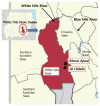Epidemiological Survey on Schistosomiasis and Intestinal Helminthiasis among Village Residents of the Rural River Basin Area in White Nile State, Sudan
- PMID: 31104405
- PMCID: PMC6526222
- DOI: 10.3347/kjp.2019.57.2.135
Epidemiological Survey on Schistosomiasis and Intestinal Helminthiasis among Village Residents of the Rural River Basin Area in White Nile State, Sudan
Abstract
There have been some reports on schistosomiasis of school children in Sudan's Nile River basin area; however, information about the infection status of Schistosoma species and intestinal helminths among village residents of this area is very limited. Urine and stool samples were collected from the 1,138 residents of the Al Hidaib and Khour Ajwal villages of White Nile State, Sudan in 2014. The prevalence of overall schistosomiasis and intestinal helminthiasis was 36.3% and 7.7%, respectively. Egg positive rates were 35.6% for Schistosoma haematobium, 2.6% for S. mansoni, and 1.4% were mixed. The prevalence of schistosomiasis was significantly higher in men (45.6%) than in women (32.0%), in Khou Ajwal villagers (39.4%) than in Al Hidaib villagers (19.2%), and for age groups ≤15 years old (51.5%) than for age groups >15 years old (13.2%). The average number of eggs per 10 ml urine (EP10) of S. haematobium infections was 18.9, with 22.2 eggs in men vs 17.0 in women and 20.4 in Khou Ajwal villagers vs 8.1 in Al Hidaib villagers. In addition to S. mansoni eggs, 4 different species of intestinal helminths were found in the stool, including Hymenolepis nana (6.6%) and H. diminuta (1.0%). Collectively, urinary schistosomiasis is still prevalent among village residents in Sudan's White Nile River basin and was especially high in men, children ≤15 years, and in the village without a clean water system. H. nana was the most frequently detected intestinal helminths in the 2 villages.
Keywords: Schistosoma haematobium; Schistosoma mansoni; Sudan; intensity of infection; intestinal helminth; prevalence.
Conflict of interest statement
The authors declare that they have no competing interests.
Figures
Similar articles
-
Praziquantel treatment of school children from single and mixed infection foci of intestinal and urogenital schistosomiasis along the Senegal River Basin: monitoring treatment success and re-infection patterns.Acta Trop. 2013 Nov;128(2):292-302. doi: 10.1016/j.actatropica.2012.09.010. Epub 2012 Sep 26. Acta Trop. 2013. PMID: 23022016
-
[Epidemiologic study of intestinal helminthiasis in the valley of the Guerléo River (North Cameroon)].Bull Soc Pathol Exot Filiales. 1983 Nov;76(5):689-97. Bull Soc Pathol Exot Filiales. 1983. PMID: 6673860 French.
-
Schistosomiasis in infants and preschool-aged children: Infection in a single Schistosoma haematobium and a mixed S. haematobium-S. mansoni foci of Niger.Acta Trop. 2010 Sep;115(3):212-9. doi: 10.1016/j.actatropica.2010.03.005. Epub 2010 Mar 19. Acta Trop. 2010. PMID: 20303925
-
A meta-analysis of changes in schistosomiasis prevalence in Zambia: implications on the 2020 elimination target.Parasitol Res. 2020 Jan;119(1):1-10. doi: 10.1007/s00436-019-06534-0. Epub 2019 Nov 26. Parasitol Res. 2020. PMID: 31773307 Review.
-
Circulating Anodic Antigen (CAA): A Highly Sensitive Diagnostic Biomarker to Detect Active Schistosoma Infections-Improvement and Use during SCORE.Am J Trop Med Hyg. 2020 Jul;103(1_Suppl):50-57. doi: 10.4269/ajtmh.19-0819. Am J Trop Med Hyg. 2020. PMID: 32400344 Free PMC article. Review.
Cited by
-
Urogenital schistosomiasis in schoolchildren in the lake zones of Kankossa and Oued Rawdha, southern Mauritania: The first parasitological and malacological survey.PLoS Negl Trop Dis. 2024 Sep 25;18(9):e0012505. doi: 10.1371/journal.pntd.0012505. eCollection 2024 Sep. PLoS Negl Trop Dis. 2024. PMID: 39321164 Free PMC article.
-
Genetic Diversity in Drug Transporters: Impact in African Populations.Clin Transl Sci. 2020 Sep;13(5):848-860. doi: 10.1111/cts.12769. Epub 2020 Mar 31. Clin Transl Sci. 2020. PMID: 32100958 Free PMC article. Review.
-
Impact of seven years of mass drug administration and recrudescence of Schistosoma haematobium infections after one year of treatment gap in Zanzibar: Repeated cross-sectional studies.PLoS Negl Trop Dis. 2021 Feb 12;15(2):e0009127. doi: 10.1371/journal.pntd.0009127. eCollection 2021 Feb. PLoS Negl Trop Dis. 2021. PMID: 33577601 Free PMC article.
-
Prevalence and Risk Factors of Schistosomiasis in Sudan: A Systematic Review and Meta-Analysis.Cureus. 2024 Nov 19;16(11):e73966. doi: 10.7759/cureus.73966. eCollection 2024 Nov. Cureus. 2024. PMID: 39703308 Free PMC article. Review.
-
Comparison of the Change in the Prevalence and Intensity of Schistosoma haematobium Infection Between High and Low Prevalence Areas of White Nile State, Sudan.Korean J Parasitol. 2020 Aug;58(4):421-430. doi: 10.3347/kjp.2020.58.4.421. Epub 2020 Aug 25. Korean J Parasitol. 2020. PMID: 32871636 Free PMC article.
References
-
- Alum A, Rubino JR, Ijaz MK. The global war against intestinal parasites-should we use a holistic approach? Int J Infect Dis. 2010;14:e732–738. - PubMed
-
- Lo NC, Addiss DG, Hotez PJ, King CH, Stothard JR, Evans DS, Colley DG, Lin W, Coulibaly JT, Bustinduy AL, Raso G, Bendavid E, Bogoch II, Fenwick A, Savioli L, Molyneux D, Utzinger J, Andrews JR. A call to strengthen the global strategy against schistosomiasis and soil-transmitted helminthiasis: the time is now. Lancet Infect Dis. 2017;17:64–69. - PMC - PubMed
-
- World Health Organization Fact Sheet on Schistosomiasis. [Internet] Available from: http://www.who.int/mediacentre/factsheets/fs115/en/
MeSH terms
Supplementary concepts
Grants and funding
LinkOut - more resources
Full Text Sources
Miscellaneous



